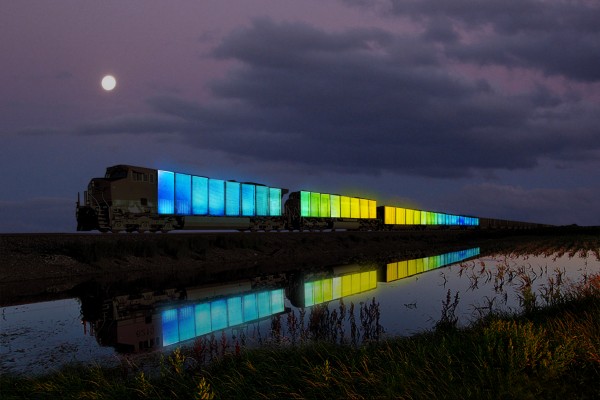Off the Rails: Station to Station in Oakland
Billed as “an artist-driven public art project,” the cross-country trainride/mobile concert/art exhibit stops in Oakland and we’re there to review it
STATION TO STATION – Oakland Happening
16th St Station
Oakland, Ca
9.28.13
On the walk through West Oakland, to the decades neglected 16th St. Station, my photographer and I speculated on the coming evening; a forecast of projected events in lieu of concrete, specific information. We were walking to the station, we had those coordinates, but once we arrived, there was no telling what would transpire, of what order, or magnitude, or duration. The official website stated an opening time of 6 to 9:45, but surely that was a mistake, that any festival could possibly set up an elaborate rig, bring in hordes of talent, and pack it all up a mere four–not even four–hours later.
We reached the end of 16th St. and found Station to Station, identified by chain-link fences, food trucks, and a snaking line of tight jeans, leather jackets, and flannel shirts. Fearful of waiting behind all that humanity, I approached security, desperate for a shortcut, and we were escorted through with great urgency, as if we would miss an integral part of the show. We signed our releases, retrieved our wristbands, and had a brief, yet haunting, standoff with a sticker dispensing hashtag ambassador. On every passerby, he reached out and placed a sticker, reminding us how we could help publicize the event. I turned the corner and threw it away.

Inside, I looked about in a hurry, eager to check if any event was underway, if we’d missed any precious spectacle. Despite the urgency at the front gate, the venue was almost empty; small throngs of people gathered at the edges, but no attractions, no live sounds. We took advantage of open space and began a proper reconnaissance of the field, starting, of course, with the bar. After waiting behind an elderly couple who had no clue about how to order a cocktail, or what a cocktail even entailed, I needed simplicity and went with beer–an old friend from Southeast Asia: Tiger. It’s not the best beer–probably not worth the import–but its bitter familiarity warmed me to the occasion.
Next on the hit list, we crossed over to the art installations, the white, black, and red (red? yellow maybe?) tents signaling interior importance. The black tent was a maze, pitch like the outside, save provided headlamps. Having seen the scope from the outside, I knew it wouldn’t wrap out into a proper labyrinth, but we investigated every nook and corridor, finding only bizarre silver scrawlings and bewildered fellow entrants. Confusion had, we moved on. The white tent was a disco-heaven daydream; all white everything, with mirrors on every wall. To add to the hallucination, a small child held court on the bed in the center of the tent. What am I telling you for? Look for yourself:
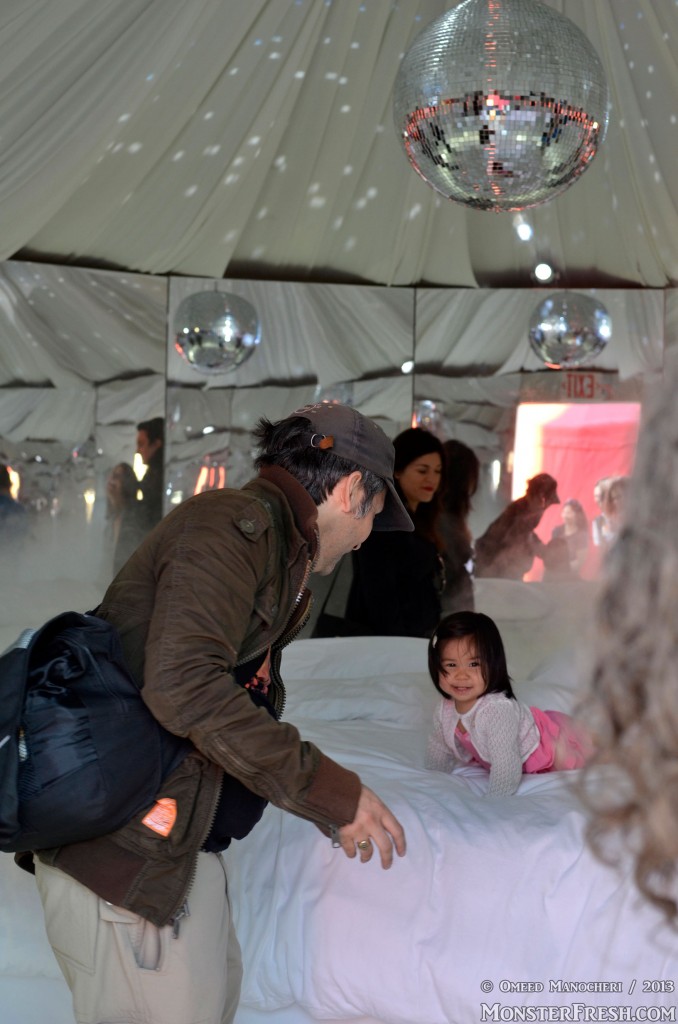
We peeked into the red (or yellow) tent and decided it wasn’t for us. Instead, we chased the only current source of noise, apart from the growing hum of humanity, a distant DJ tucked in the back corner. Coming closer, there were two of them, sitting side by side, over a small body of water. The girl dipped a record into the water, pulled another out, and set it aside. Was she washing the records, some conceptual statement on censoring music in mass media, by literally cleaning the vinyl? As it turned out, no, it was only an underwater turntable, a much more interesting and politically benign piece.
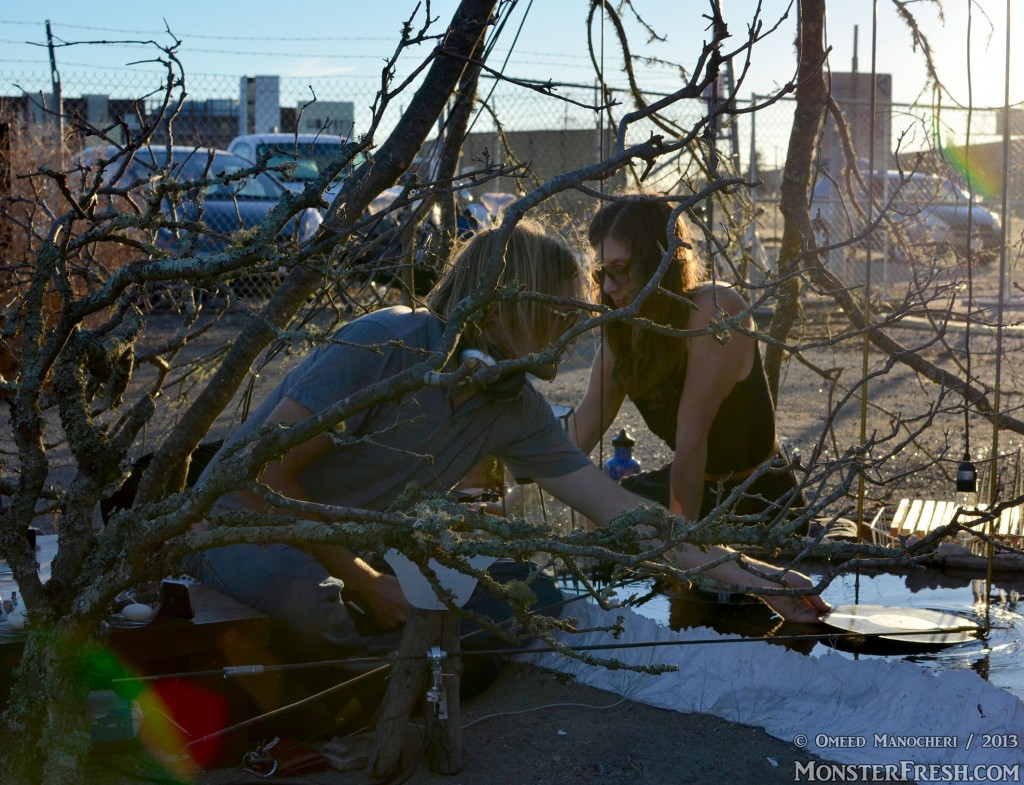
After a few more submerged jams, we joined the largest collective in the middle, in front of metal scaffolding with men standing on ladders behind it, ready to light, either fireworks or flares. Spectacle be damned, it was flares: the opening bell of the festival.

Let’s clarify something, really quickly; I said “festival,” just now, but that’s not the right word. Official literature calls it a “public art project” or “happening;” the latter more appropriate, but still not quite it. A slightly interactive, mixed media performance is closer, but that vagary doesn’t clarify much. Really, I had no precedent in my personal experience to the beast before me, that I lurked within. With no posted or announced set times, no indication as to what would happen–where, when, or even with whom–a disorderly mix of live music and performance pieces, and makeshift galleries, the masses wandered between sections, unsure of what they’d find around the corner; tending to hang towards the back of each display, so as not to miss the next surprise. That element certainly thrilled the thing up, made it a bit more exciting, but I could have done without the paranoia of missing the next big thing; I could have used some certainty.
The first live music came from the main stage. With bongo rhythms, dazed reggae, and chanting vocals, I pegged them as Sun Araw and the Congos. A mellow blending of disciplines, Sun Araw provided enough psychedelic skew to twist familiar melodies fresh, setting the experimental tone for the evening.
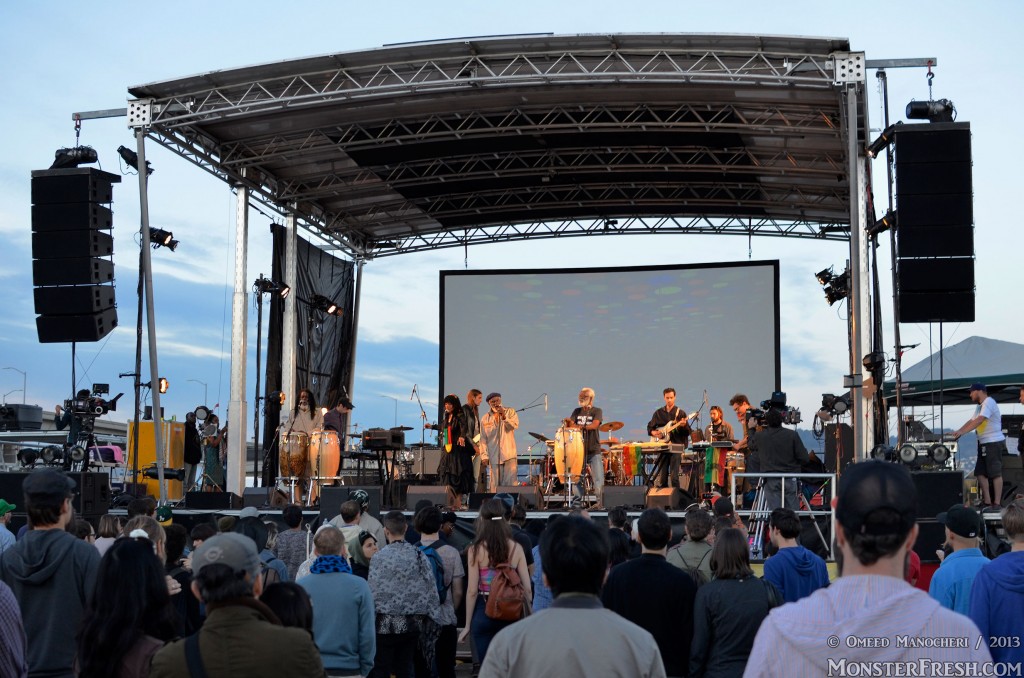
After 20-or-so minutes, they ended, abrupt and sudden, setting the rule for the night, and more noise rattled out of the station. Inside the grand old dame, still full of majestic arches and impressive friezes, Lia Ices took a side stage carved into an old stairwell, tucked in the corner in front of some faded spray paint. The minimal shine pop trio–all hatted–ran through bouncy melodies, their contagious energy limited only by their obvious self-awareness.
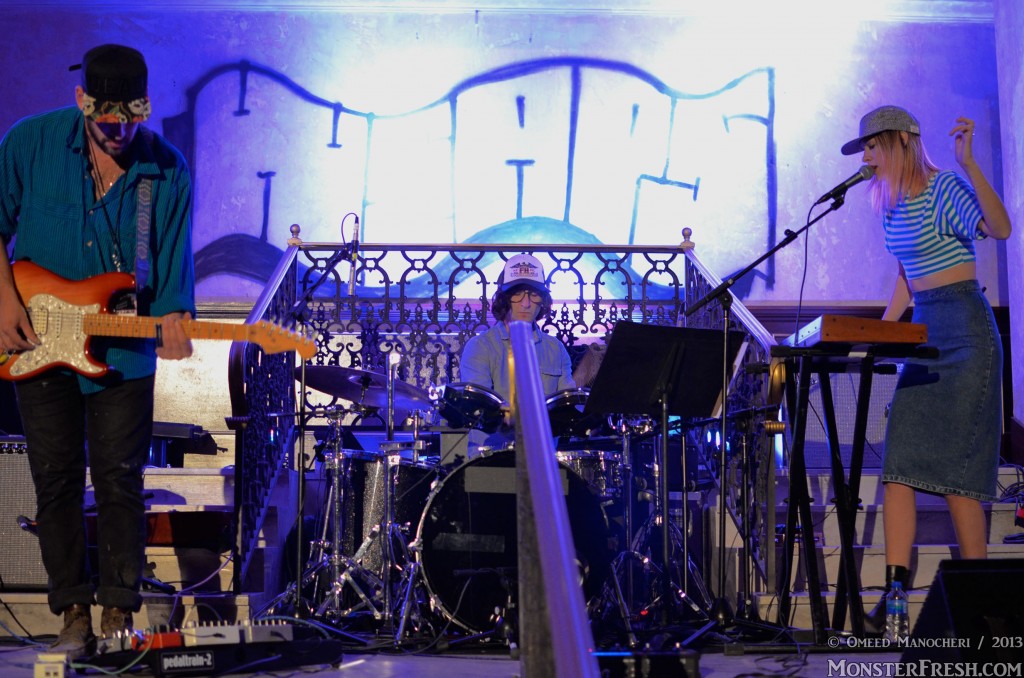
Outside of the station, between the main building and some auxiliary structure, a collection of washed out and distorted prints held court in the alley, pasted upon and around aged graffiti. A dead end, a loop cut into concrete, we shuffled the circuit, pausing at each piece long enough to appreciate it without breaking the communal pace, which whirred a little quick for my eyes.
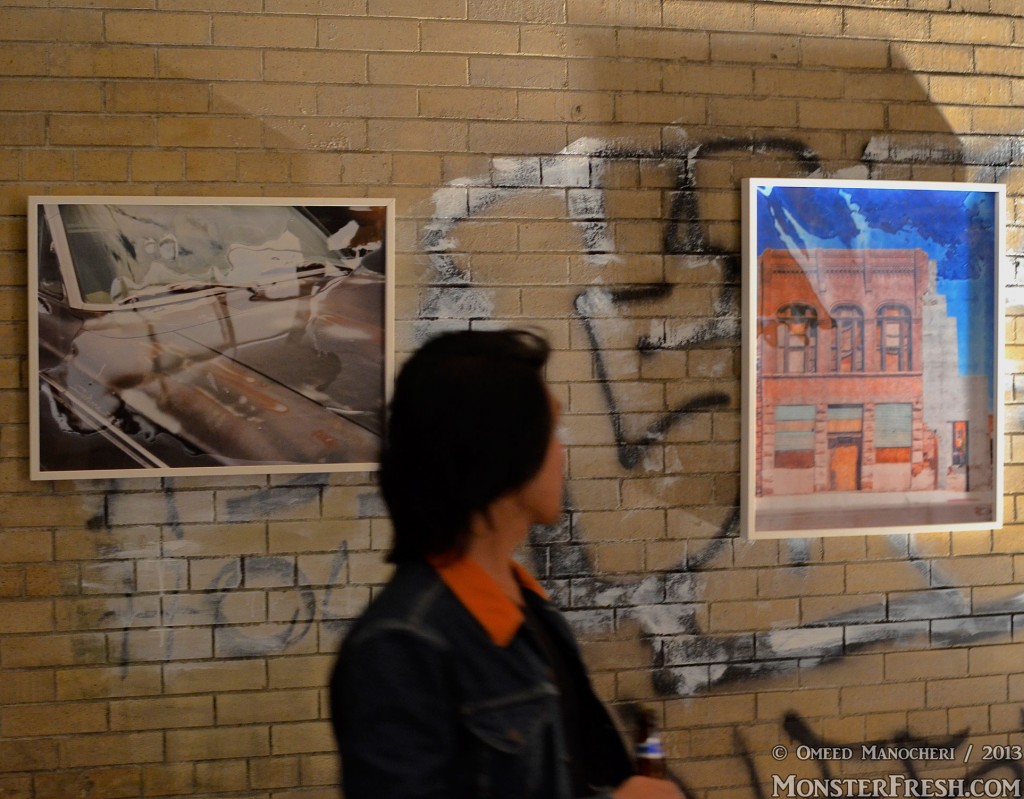
More noise and we whipped back to main stage, expecting Dan Deacon, maybe No Age. Instead, over the PA, two auctioneers traded ascending vocal lines, rattling off disparate prices and items, melding their varied pitches into one spiraling sound. Magnifying in volume and in pitch, the duo peaked and converted chatter into outright belting. At this point, I happened to look behind, over my shoulder; intent on the stage, sure that it was the source of coming spectacle; I’d neglected the mini-stage from which these verbal wizards performed. Just as I’d tracked their location, they stopped, stepped down, and my gaze drifted back to main stage.
Another duo came out, weathered but lively, and took their places behind drums and guitar–No Age. They broke right into an extended distortion jam, recalling the noisier chunks of Neil Young’s catalog, while mirrored split-screen train footage rollicked by in the background. Absorbing at first, the groove lingered a little long, the monotonous drone mocked by the the constantly moving footage. As guitarist, Randy Randall and drummer/singer, Dean Spunt finally followed suit and crashed into a climax, video responded with a series of airplane takeoffs.
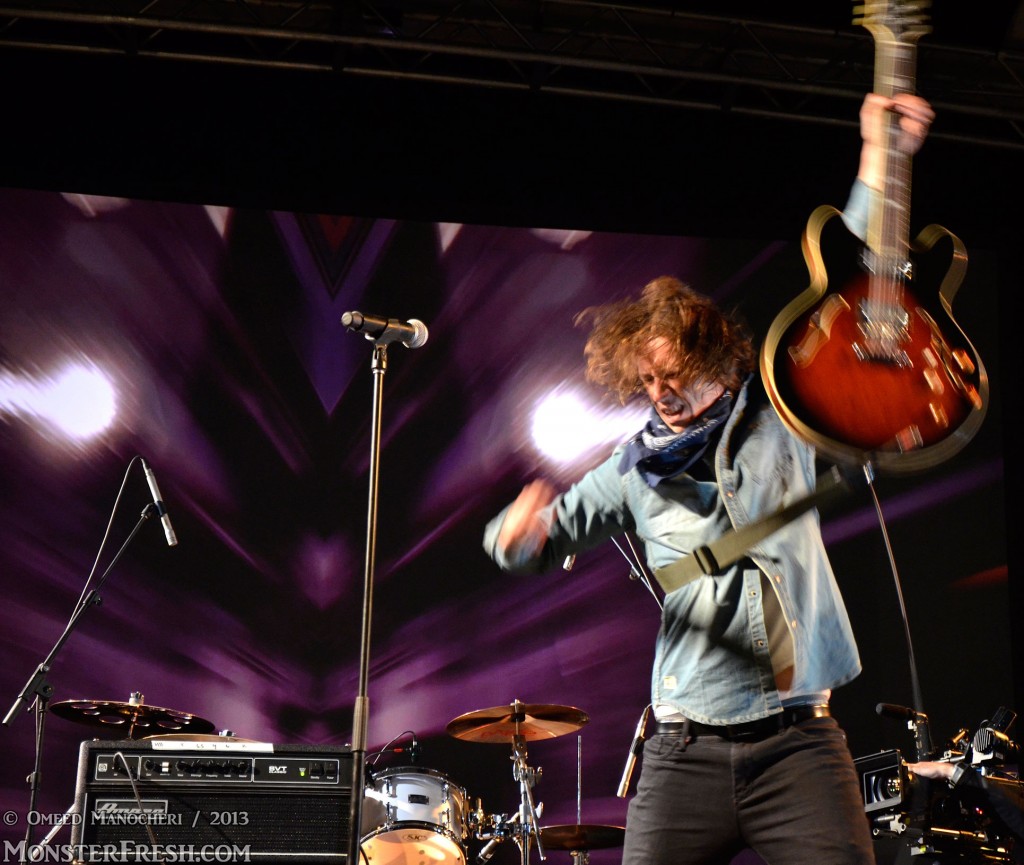
No Age moved into more conventional, vocal accompanied songs and a slew of attendees filed in and asked after the act, no one quite sure who they were watching. Those who directly addressed me, I provided with an answer, but I fell short of making an official, public address, even though it felt like someone should.
We cut out early and headed back inside the station, now at capacity and gussied up with dramatic lighting.
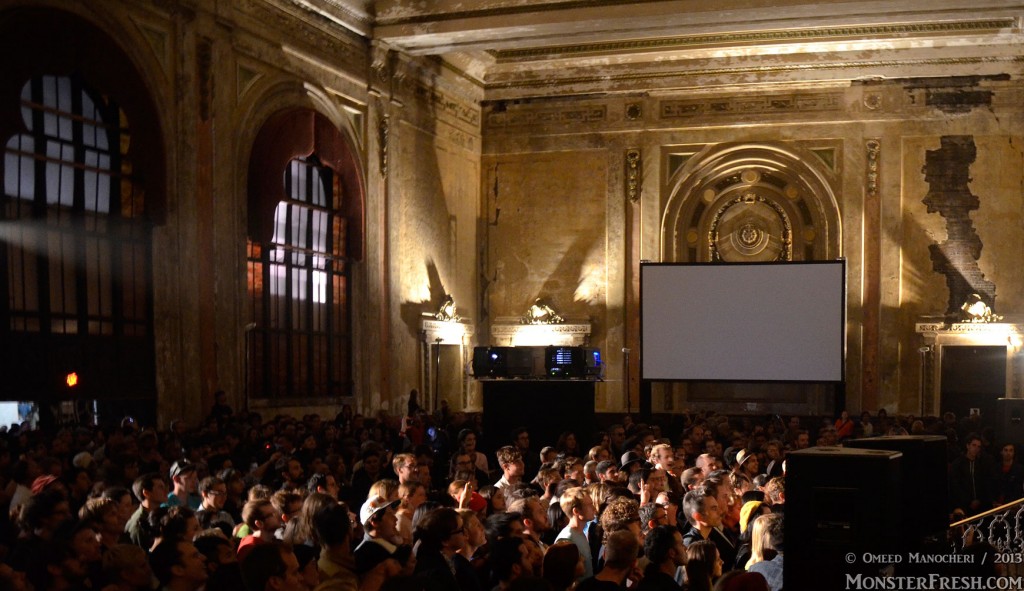
Again, no certainty on the upcoming artist, but from the prominent synths in the set-up, I assumed that it would be Twin Shadow. We wriggled up front–around the central hub, past the looming screens playing interviews with participating artists–and staked out our spot as assumption proved correct. Dressed in matching silver suits, project mastermind, George Lewis Jr., and synth player, Wynne Bennett made good on the space-age promise of their fashion choice, and delivered twinkling, downtempo versions of Twin Shadow’s best singles. Each tune was familiar, yet chopped enough to be foreign, recognition clinking into place with the entrance of the central hook, or lead vocal line. Between the fashion and sound, they seemed to have stepped straight out of 1970’s Berlin, taking more than a few cues from Bowie and his crew.
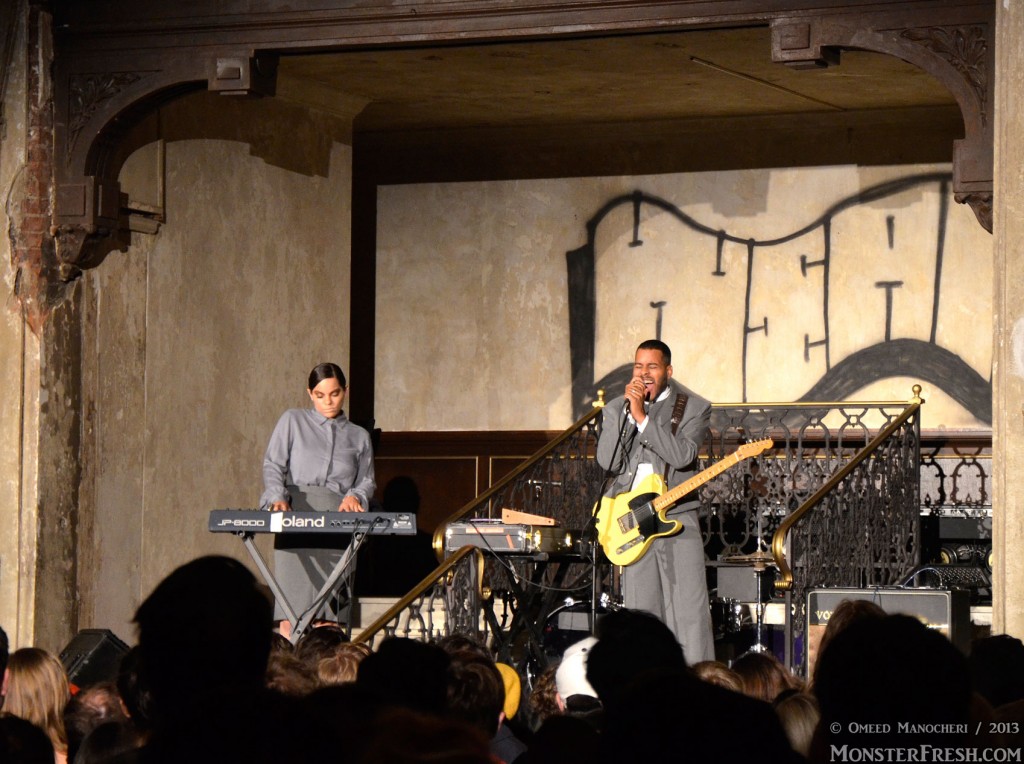
The highlight came in a space lounge send-up of Confess single “Five Seconds,” a roaring rocker on record, perfect for a motorized getaway, recast as slow grind baby-making music, or maybe the theme for a mid-80s erotic thriller. With the extra space, Lewis threw more menace into the vocals, tossing out the odd guitar blast and teasing the coming breakdown. Engulfing, tense, and melodic with just the right touch of drone, their performance may be the closest this world comes to seeing Prince front Kraftwerk.
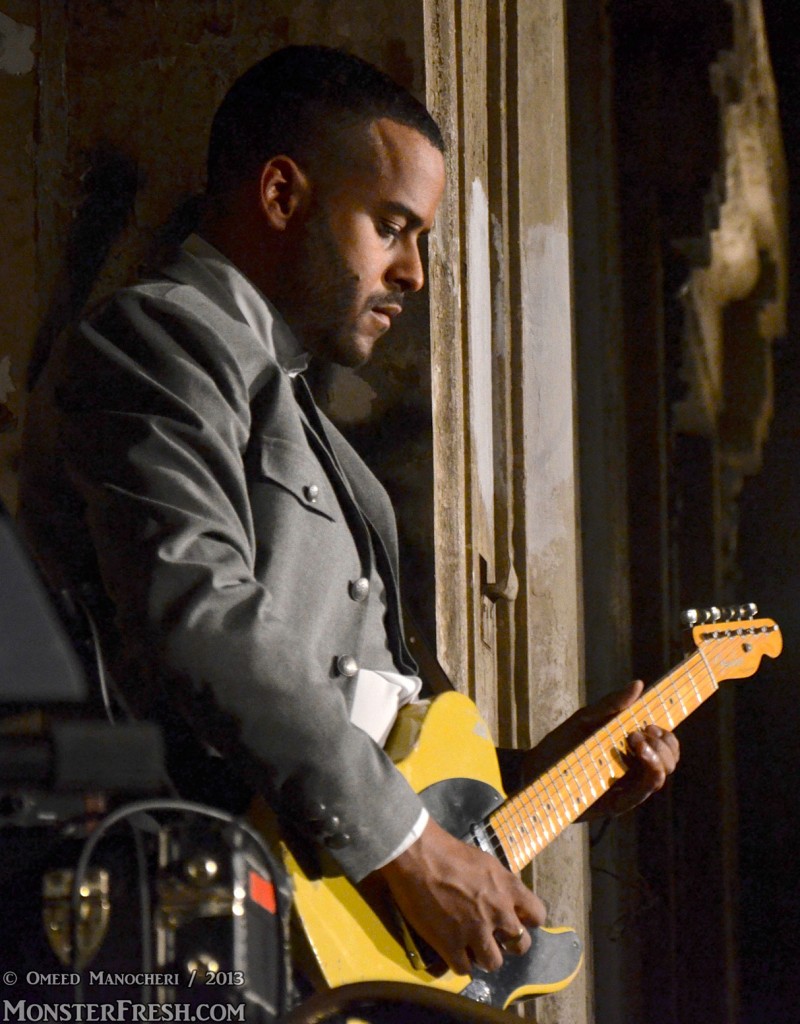
Their set concluded, I filed outside with the rest of the masses and found another band already underway; their thunderous post-punk and feminine formation giving them away as Savages. I’d seen them, four months prior, in an intimate club setting, so there was no need to press to the front for closer inspection. Hanging towards the back, waiting for a rendezvous with my photographer, I took in their vision of a Patti Smith-inclined Joy Division, riding an endlessly bouncing drum line and powerfully yelped vocals.
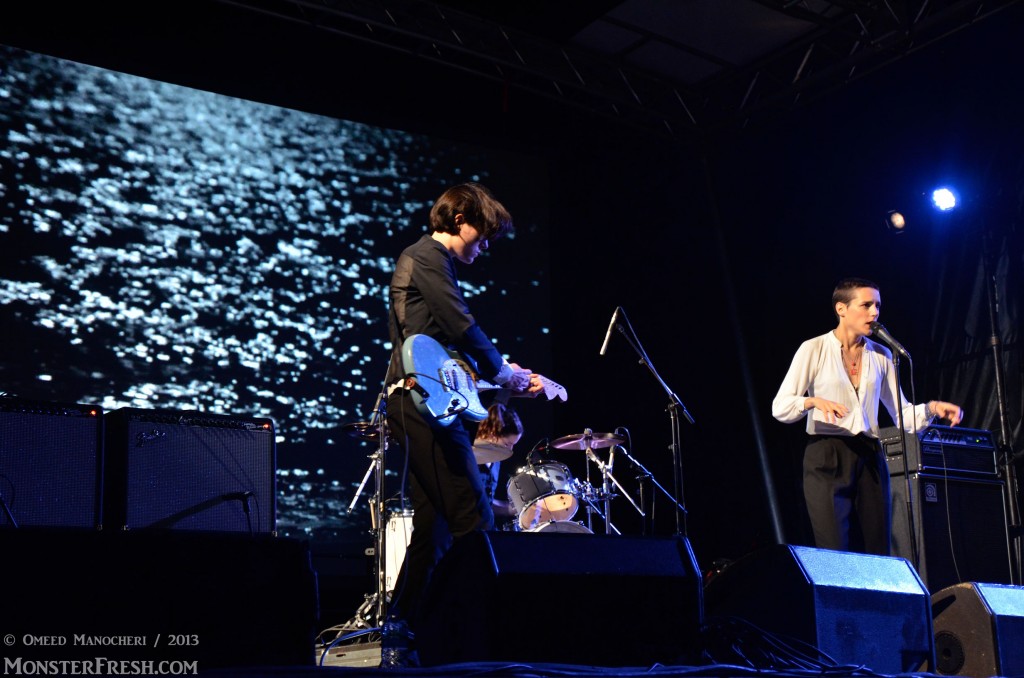
The side screens never displayed band footage, the traditional custom of such affairs, rather they ran through accompanying visuals–sometimes proper fits to the music, more often, aesthetic non sequiturs. Near the conclusion of Savages’ set, an intricate Rube Goldberg device popped into the transmission, a slow unraveling of ropes, balls, and counterweights spilling progress towards an unknown, distant goal. After a few minutes of detail, the machine looped back to the start and ended abruptly, an intricate maze to nowhere, a rather fitting summation of the evening.
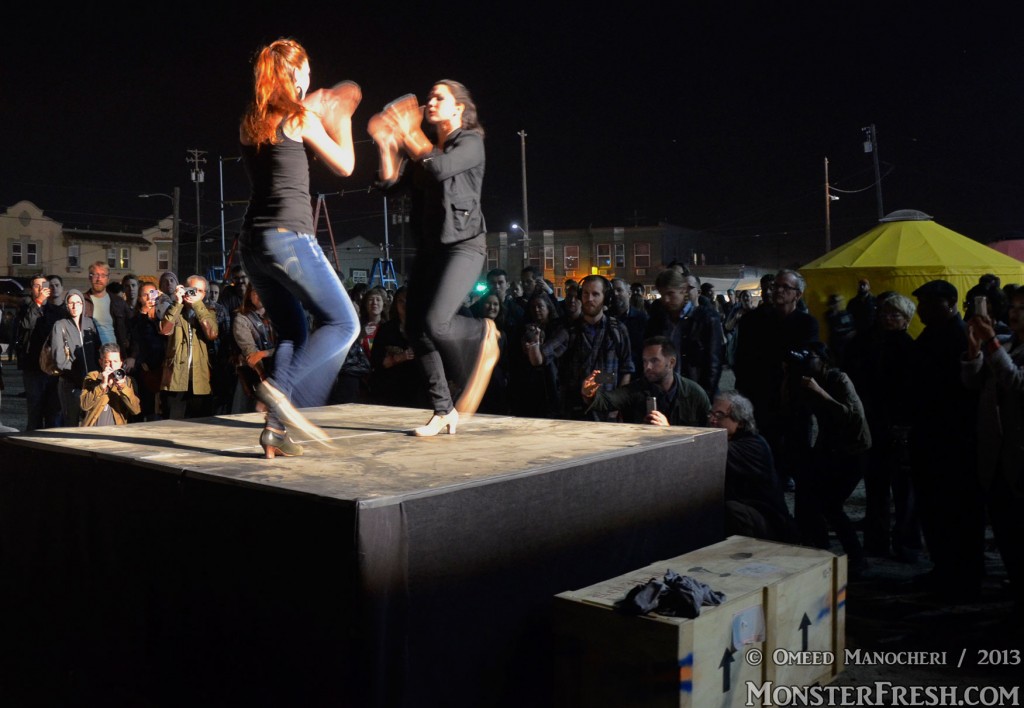
There was only one act left on the bill, Dan Deacon, and we waited for his arrival while the above tap dancers (may not be the right characterization, but I won’t claim to know better) stomped out an increasingly complex and speedy rhythm. True to reputation, when Deacon did appear, it came in the form of a crawling gypsy caravan through the crowd, led by a neon glow and the first sputters of dance music. The pied piper of Wham City made his way to the front of the stage, still on the audience’s level, and set up his instrument panel, as concertgoers crowded around. He started off, sublimely absurd, by entreating us to point to a star in the sky, pollution limiting us to only one option, which might have only been a plane anyways. We were to point to that star, to fixate on it, and think about a lost love; not in a remorseful, longing sort of way, but in a sweet remembrance of an impacting personal relationship. Next, we lowered our fingers, now targeting a stranger in the surrounding audience, as he ripped into his signature demented pixie vocals.
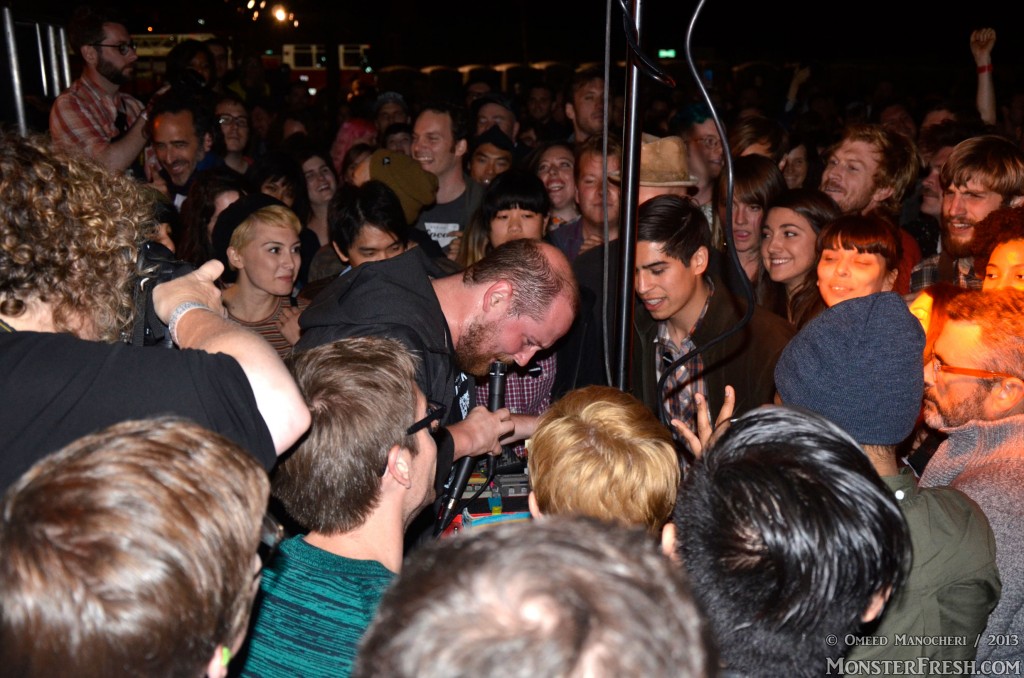
Continuing his post-modern deconstruction of the concert experience, Dan had the crowd form a large circle, explaining that there would now be an informal dance contest, with three rules: be sassy as fuck at all times, contestants pick their replacements, and you have to dance if chosen. Sending normally reserved adults into fits of youthful euphoria, Deacon provided running commentary and a steady soundtrack of funhouse electronica, playing the perfect carnival barker.
Taking the ruse even further, the composer/electronics wizard divided the crowd down the middle and chose leaders for each side, asking the rest of us to repeat their exact movements, and for our leaders to move in logistically possible ways. These instructions came with a caveat, which he considers universal: “When your leader does badly, you replace him with yourself.”
To conclude, Deacon alerted us to download his iPhone application and hold our phones aloft, and the smart phone army quickly complied. As he fiddled with his instruments, sound seeped out, not through the PA, but from the handheld speakers filling the air. Building into a proper beat, the PA retook hold and phone screens flashed in alternating waves, creating a user derived visual that used every audience member as a prop.
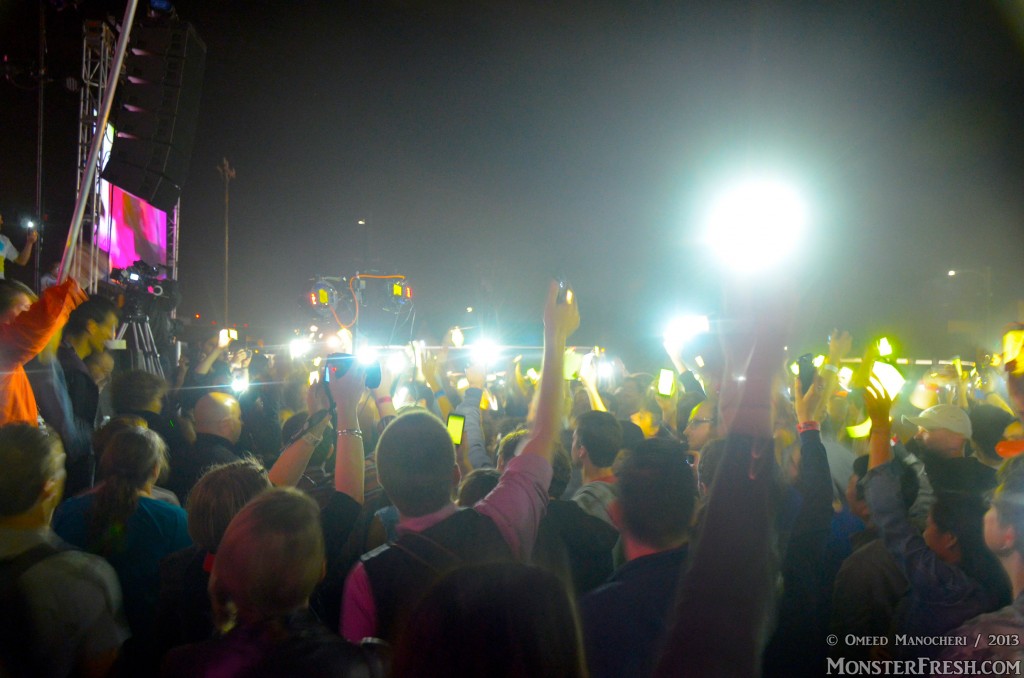
I didn’t know what to make of what happened to me; how much temporary entertainment counter-balanced general confusion and set length frustration; and whether or not NY artist/organizer, Doug Aitken, Levi’s, and their artistic partners achieved their goal of an immersive visual and musical art experience, or just a really loud and fairly corporate tie-in. They’d crossed the country by train, all the way from New York to California, roping in acts as varied and storied as Suicide, Mavis Staples, Patti Smith, Beck, and Jackson Browne, surely taking that month to refine the show, to grease the wheels and get logistics down to a science. Maybe they’d only worked with local crews–they had little consistency between stops–or the bureaucratic hurdles were too great in each location. There’s no telling who or what is to blame for the overall mediocrity of the event, for the failure of mining more moments of greatness from the present talent, and capitalizing on potential, rather than making naked plays to capitalism.
At the very least, they could have gone past 9:45.
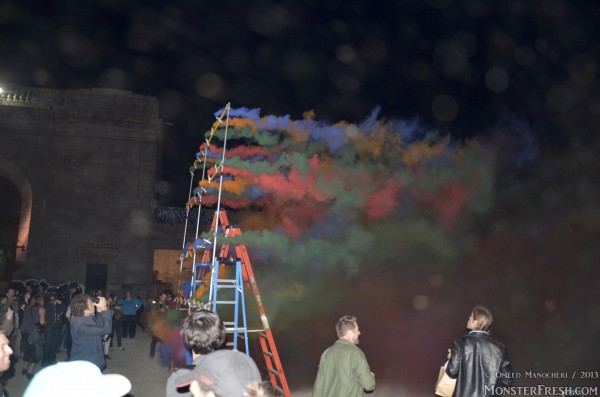
http://vimeo.com/76383117
